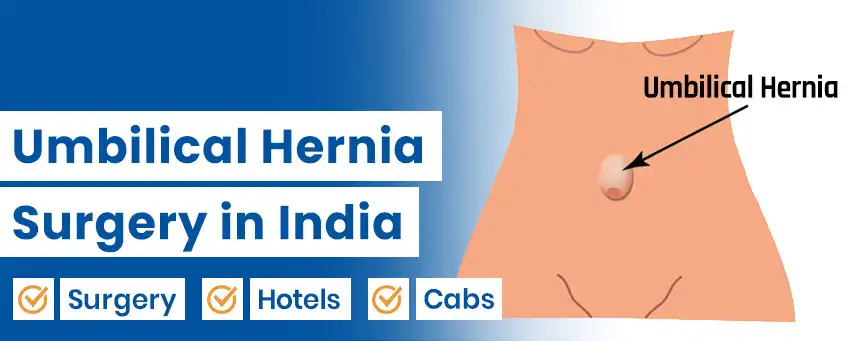

The foetus is connected to a mother while inside the womb through the umbilical cord. The umbilical cord in the foetus passes from the abdominal wall muscles through a small opening. This opening closes after the birth. When it does not close properly, it forms a weak spot as the layers of the abdominal wall do not join completely. Due to this, the organs in the abdominal cavity bulge through this weak spot. This is known as an umbilical hernia. The umbilical cord hernia is usually painless, and many times the opening is closed on its own. However, if the umbilical hernia is not closed when the child reaches four years of age, treatment is required. The umbilical hernia disease can be visible usually when the baby cries, which makes the belly button protrude. The umbilical hernia disease is mostly common in babies, but it can also occur in adults. The umbilical hernia disease can cause pain and discomfort in adults.
Every year, many patients from African countries like Kenya, Congo, Ghana, and Cameroon travel for umbilical hernia surgery in India. Indian hospitals provide the right treatment, and the cost of the treatment is also low. The reason why they choose India is that they receive high-quality medical service at a lower cost, which is not available elsewhere. In other countries, with good medical service, the cost is very expensive, which is not affordable for many African patients. Also, the visa application is easy and the government is providing different visa packages. The Indian hernia surgeons are highly experienced doctors, and they possess vast knowledge and skills to provide the right treatment. The African patients feel safe and reliable with the surgeons in India for their treatment procedures.
There can be different types of umbilical hernia based on their condition. The different umbilical hernia types are listed below:

The reducible hernias are the ones that can be pushed back into their place by gently massaging them. Most of the congenital umbilical hernias are reducible.
As the name suggests, the hernias that cannot be pushed back into their place are known as irreducible hernias.
This type of hernia occurs when the intestine gets stuck in the bulged abdominal muscles and causes tenderness and pain.
It is a condition where the blood supply to the intestine (bulged organ) is cut off. Due to this, the tissue dies. It is considered a medical emergency because if it is not treated on time, it can cause infection and result in other complications.
The umbilical hernia disease is mostly common in infants. When the foetus is developing inside the womb, there is a formation of a small opening in the abdominal muscles. The umbilical cord passes through this opening. After childbirth, this opening closes on its own. If it does not close, it causes the congenital umbilical hernia where the internal organs like the intestine, fatty tissue, etc. bulge through the weak spot (opening). The umbilical hernia can also occur in adults when there is too much pressure buildup on the abdominal muscles; the fatty tissues, intestine, etc. bulge through the weak spot in the abdomen. This pressure on the abdominal wall can be a result of the following conditions, which cause umbilical hernia in adults.
The most common and noticeable symptom of umbilical hernia is a bulge that is visible on the navel. It looks like a lump that is clearly visible when the child cries, passes faces, or coughs, and it may be rarely visible when the child is relaxed and lying down. The symptoms are the same for the umbilical hernia in adults; the only difference is that in adults it can cause discomfort and pain. A few symptoms that give you signs to visit your doctor include:


An expert general surgeon treats umbilical hernias. CureIndia helps connect you with the leading doctors in India for your umbilical hernia repair. The surgeons associated with CureIndia are experienced, skilled, and expert in their fields. Let us hear from the best umbilical hernia surgeons in India.





The total cost of umbilical hernia surgery in India depends on many factors like the cost of travelling, your choice of hospital and the city where the hospital is, the cost of medication, surgeon’s fees, whether the mesh is used in the surgery or not, insurance coverage, etc. However, the average cost of umbilical hernia surgery ranges from about $1,019 to $1,919. However, the surgical procedure for umbilical hernia can shoot up to $3,000. The cost of the same procedure in the USA may cost you around $4,000 to $11,000, and in the UK, it may cost you about $3888. Hence, the cost of the umbilical hernia repair surgery is much lower in India as compared to many other developed countries.
| Treatment | Cost in India | Stay in India |
|---|---|---|
| Umbilical Hernia Surgery in India | $2,000 | 7 Days |
| IPOM Laparoscopic Umbilical Hernia Surgery in India | $3,000 | 7 Days |
The umbilical hernia disease can only be diagnosed by physical examination. Your healthcare provider will check the bulge and surrounding area for swelling. The bulge and swelling are more noticeable when the baby cries. Your child’s paediatrician will carefully check whether the hernia is reducible or irreducible. Your healthcare provider will ask about your medical history. If the hernia is incarcerated or strangulated, it is also checked during the diagnosis. If the hernia is strangulated, your doctor may also run a blood test to check for any signs of infection. If the hernia is irreducible, your doctor may also run imaging tests like ultrasound, X-ray, CT scan, or MRI.
In most cases, the infant umbilical hernia is cured on its own when the baby reaches about 3 to 4 years of age. Sometimes, if the child has a reducible hernia, then your doctor may be able to push the bulge back in its place by gently massaging it. Do not try it on your own; the incorrect technique may lead to other complications. When the abdominal wall does not close, your surgeon may recommend surgery. In adults, surgery is the only option for treating the umbilical hernia disease. Depending upon the patient (age, health, size of umbilical hernia, etc.), your surgeon will decide one of the following surgeries.
This procedure is performed under general anaesthesia, which means the patient will be unconscious during the surgery. Your surgeon will make only one incision at the belly button area, push the bulging organ into its place in the abdomen, close the weak area by first placing a mesh (to provide strength to the abdominal wall) and then stitching it together, and close the incision site with stitches.
It is also known as a keyhole surgery where a few small incisions are made in the abdomen by your surgeon, then inserting a laparoscope from one incision and surgical tools from other incisions, your surgeon performs the surgery. The laparoscope has a camera and a light attached to it, which shows the video on a TV monitor. Your surgeon looks at this monitor and performs the surgery. After pushing the protruding tissue back in place, your surgeon places a mesh to provide strength to the weakened area and connects the weak muscles with stitches. After this is done, the surgical instruments are removed, and the incision site is then closed with stitches.
Usually, after a successful umbilical hernia repair surgery, the patients are discharged from the hospital on the same day. It is normal to feel a little uncomfortable and sore for a few days after the surgery. Your doctor will prescribe a pain-relieving medicine to consume for a couple of days. If your child had an umbilical hernia repair surgery, he/she may cry a little more than usual and may be sleepy after the surgery. It will get better with time as the baby starts to heal. If any adult patient had umbilical hernia repair surgery, they are mostly discharged from the hospital on the same day after a few hours of surgery. If you can’t eat or drink and keep vomiting, then you may have to stay at the hospital overnight or maybe for 1-2 days. Before discharging you from the hospital, your surgeon will inform you if you need to come back for the follow-up appointment and also give you a few instructions to follow at home.
You may feel tenderness, swelling, and bruising around the incision site for a few days, which is normal, and it will be healed within a week. However, if the swelling and pain do not reduce, contact your surgeon immediately. Keep in mind that pain medicines are different for adults and children, so before giving any medicine to your child, ask your doctor first. Also, make sure to eat healthy and light food to avoid constipation, as straining while passing stools can lead to pain and discomfort in the wound area. Adults should avoid alcohol, smoking, driving, etc. for at least 24 hours. You can resume your normal activities slowly over time within 2 weeks after the inguinal hernia surgery. Keep moving a little, but not too much. Gentle exercise like walking aids in the healing process. At the same time, avoid lifting heavy weights and doing any exercises that put pressure and strain on the affected area for about 4 to 6 weeks.
The umbilical hernia disease occurs when the opening in the abdominal wall that allows the umbilical cord to pass does not close properly as it should during the birth of a child. The umbilical hernia may occur when you are an infant, or the infant umbilical hernia may not develop until later in life. The umbilical hernia can be closed on its own in infants but cannot be cured on its own in adults, and it needs surgery to repair. If proper treatment is not received, it can further cause other problems in the body. In India, both of the surgeries (laparoscopic and open) are available. You can get the best umbilical hernia surgery at the lowest cost in India; as you can see in the cost part mentioned above, the cost is very low. The hernia hospitals in India have the latest facilities and infrastructure and provide premium medical services. So, it is worthwhile to consider getting umbilical hernia surgery in India.
